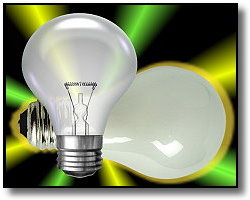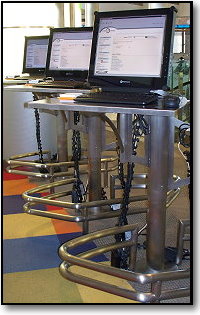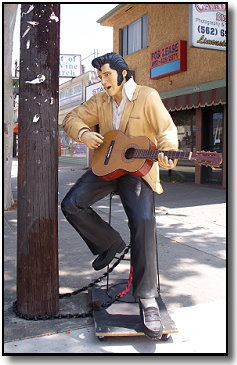|
|
||||
|
<< September
<< July/August
<< July/August
<< September
<< Nov/Dec 2014
<< June
<< June
<< Part I
(June/July)
<< June
<< June
<< June
<< Part I
(June/July)
* * * |
Work in Progress - Stories for Summer 2009
Last year's gasoline/petroleum "Petromorphosis" series concluded on a fairly positive note, with local gasoline prices dropping back below the $2 mark - at least for a while. Although prices have inched back up in recent months, a more vexing problem confronts many this year -- a nationwide recession and national unemployment rate (as of June) of 9.5%. In California, that overall rate is even higher, estimated at 11.5% as of May. But even that figure is only an average. For the areas including the cities covered in the concert listings on the site, (May) unemployment rates range from 8.6% in Orange County and 11.4% in Los Angeles County to 12.8% in San Bernardino County and 13.1% in Riverside County. (n1) A few more facts can help place the current recession and unemployment rates in context as well. According to the U.S. Labor Department's Bureau of Labor Statistics:
All this may lead to one simple question: Where are the jobs? Lists of major employers by California county can be found on the State of California Employment Development Department's website at www.labormarketinfo.edd.ca.gov/majorer/MajorER.asp, as well as more general data and profile links on the www.labormarketinfo.edd.ca.gov overview page. Many of the largest employers in the four counties covered on the site are in education and healthcare, two of the few sectors to see job growth in 2008. Another valuable but more general information resource is the U.S. Labor Department's Occupational Outlook Handbook for 2008-9, particularly the section entitled "Tomorrow's Jobs." Both can be accessed from the handbook home page at www.bls.gov/OCO/home.htm.
Today's Jobs vs. the Jobs of the Future A detailed discussion of where next year's, let alone the coming decade's, jobs might come from could fill volumes. However, given that the focus of this section of the site has been topics of technology-related consumer interest, this summer's essays will look at creating the technology-related jobs of the future, particularly through technology start-up companies. This first part of the three-part series will include a few introductory principles and vocabulary and take a brief look at potential sources of such companies -- works in progress, you might say. Probably no story is more illustrative of global technology-driven changes which have taken place in the last 20 years and companies that have risen from those changes than the story of the Internet. Before turning to the body of the essay, I would encourage those visiting this page to take 15 to 20 minutes to view a multimedia presentation from the National Science Foundation (NSF) called "NSF and the Birth of the Internet." (www.nsf.gov/news/special_reports/nsf-net). This multimedia presentation contains video footage, interviews with the creators/inventors of the internet, and historical timelines/multimedia presentations by decade from the 1960s to 2000s. It begins, "There was a time in the not so distant past when the world was not connected. But then a small group of visionaries created the internet and changed the world. This is their story . . ." Once Upon a Time Someone Had an Idea . . . Most people probably are familiar with someone in their community who has started a business like a restaurant, florist shop, catering business, or small service company. Although these types of businesses tend to be thought of as small businesses, the Office of Advocacy of the Small Business Administration (SBA) generally defines a small business as one with fewer than 500 employees (in addition to other industry-related criteria). Data from a 2007 SBA report showed that small firms employed 50.9% of the private sector work force and generated 50.7% of the non-farm private gross domestic product (GDP). (n5) Many private technology start-up companies may be thought of as small businesses by the SBA definition, though there is usually one crucial way in which they differ from other businesses. That difference is intellectual property protection, most often in the form of a patent. As defined by the U.S. Patent and Trademark Office (www.uspto.gov), a patent for an invention is the grant of a property right to an inventor, usually valid for a period of 20 years from the date on which the patent application was filed in the U.S. The right conferred by the patent grant itself is "the right to exclude others from making, using, offering for sale, or selling" the invention in the U.S. (n6) The three types of patents are utility, design and plant patents, and the majority of patent applications are for utility patents. For more information on patents visit the USPTO website or go directly to the USPTO General Information page. The number of both patent applications filed and patents granted has increased steadily throughout the history of the Patent Office. Based on information released earlier this year by the USPTO, in 2008 for the first time more U.S. patents were granted to applicants of foreign origin than to those of U.S. origin. (See PTMP Special Report, March 2009 at www.uspto.gov/go/stats/apat.pdf). (n7) . . . And Knew It Could Be More Than Just an Idea
In the U.S., the process of taking inventions and patents generated at universities and certain research institutions with federal funds and transferring them to the public sector for potential further development was made possible by several pieces of legislation passed beginning in the 1980s. The Patent and Trademark Law Amendments Act of 1980, more commonly referred to as the Bayh-Dole Act (Public Law 96-517, 94 STAT 3019), allowed for universities and small businesses to patent and license inventions made using federal funds. Prior to the passage of the Act, "discoveries made by way of federally-funded research, if not simply dedicated to the public, were owned by the government with only a non-exclusive license available to private industry. As a result, companies lacked the incentive to undertake the financial risk to develop a product based on such research. . . The Bayh-Dole Act and [later] amendments thereto have provided the basis for current university technology transfer practices, which often involve co-development and commercialization by academic institutions and private industry." (n11). The Stevenson-Wydler Act of 1980 (Public Law 96-480, 94 STAT 2311), among other things, also facilitated the transfer of federally owned and originated technologies to the states and the private sector. Other pieces of legislation passed since that time which have continued the process of transferring patents generated with federal funds for potential development in or with the private sector include:
"Of the reported disclosures that resulted from . . . $200 billion in funded research and development, 50 percent of them led to patents and 50 percent did not. Only 50 percent of the filed patents were licensed. The other 50 percent stayed in the filing cabinet. Of the signed licenses, 10 percent went to startup companies (15 percent in 2006) . . . Over 99.5% of the licenses in place generated a yearly amount less than $1 million each. [And] it was reported recently that, in the enormous University of California System, only slightly more than 4 percent of all licenses earned more than $100,000 per year." (n12) Before continuing it is important to note that not all government and university research funding is intended or designed to produce commercial products. However, with the types of research that produce results which may be translated into commercial products (whether in an academic, public or private setting), other complications arise. These include the costs and risks associated with starting any new entity, particularly a technology start-up company, and the time necessary to bring a new product to market. Sources of Start-Up Financing Just as a book can only go so far without a good plot, even the best of ideas can be taken only so far without the proper funding to bring the product or service to market. Results of a 2004 survey by AUTM found that the primary sources of funding for start-ups came from:
While some entrepreneurs are able to finance their own ventures, most cannot. Of the sources of financing listed above, two may require additional explanation. First are the grants listed in the last category. Small Business Innovation Research (SBIR) and Small Business Technology Transfer (SBTT) are grants for small businesses from the federal government administered by the U.S. Small Business Administration. Those interested in learning more about these grants can find further information at www.sbir.gov. Angel investors/groups and and venture capital firms are two of the most important sources of funding for any start-up, regardless of whether or not it is a technology-related company. Angel investors are "high net-worth individuals who invest their own money in start-up companies in exchange for an equity share of the business. . . Many angels are former entrepreneurs themselves [who] make investments in order to gain a return on their money, to participate in the entrepreneurial process, [or] to "give back" to their communities by catalyzing economic growth. Angels make a return on their investment when the entrepreneur sucessfully grows the business and exits it, generally through a sale or merger. It is estimated that angels invested $26 billion in 57,000 start-up businesses in 2007. . .[and] angels tend to invest in companies that are located near them regionally." (n14) Two of the largest angel groups in Southern California are the Tech Coast Angels (www.techcoastangels.com), and the Pasadena Angels (www.pasadenaangels.com). More information on angel groups and investors can also be found at www.angelcapitalassociation.org or www.angelcapitaleducation.org. Venture capital (VC) firms are "professional, institutional managers of risk capital that enables and supports the most innovative and promising companies. This money funds new ideas that could not be financed with traditional bank financing, that threaten established products and services in a corporation, and that typically require five to eight years to be launched." (n15) Some of today's well-known companies that were backed by venture capitalists at some point in their development include Intel, Microsoft, Apple and Google. (n16) The National Venture Capital Association (www.nvca.org) website offers a wide variety of information about venture capital organizations. Downloadable publications from the Resources --> Publications/Bookstore section of the site include the 2009 Venture Capital Yearbook (state of the VC industry and 20 years of statistics), Venture Impact (discussing the economic impact of venture capital) and Patient Capital (an overview of venture capital in medical innovation). For those unfamiliar with either angel or investor organziations, it is important to understand a primary difference between funding from these types of organizations and regular commercial bank financing. That difference is the equity stake that the individuals or groups take in a start-up company. In other words, they become part owners of the company in exchange for their financial investment. Their capital is "patient" in the sense that they can wait many years to see a return on their investment, and their money is repaid in addition to capital gains when a company is sold or begins issuing stock through an initial public (stock) offering (IPO). There also are differences between angel investors and venture capital firms, and those differences include:
Funding Sources - Angels invest their own funds directly in a business, while venture capitalists invest funds from other sources (e.g. pension funds, insurance
companies, foundations, etc.) Stage of entrepreneur/business - In general, angels invest in seed, start-up and early-stage businesses, while venture capitalists invest in
later-stage businesses (although there are exceptions) Size of investment - Venture capitalists generally invest $2 million and up in a financing round, while individual angels make much smaller investments ($5,000 to $100,000). Angel groups can make investments
in the mid-range, between most individual angels and VCs. (n17) One other organization in the Los Angeles area bringing together entrepreneurs and sources of funding bears special mention. The Los Angeles Venture Association (or "LAVA") had its first meeting in 1985, and according to material presented on the LAVA website, some of the inspiration for the organization came from actor and director Robert Redford. (n18) Over the years the organization has continued to both match investors with business ideas and build a community of venture-minded individuals in the Los Angeles area. Some of the groups events are open to the public, and you can learn more about the organization at www.lava.org. And So The Story Continues . . . The next two essays in this summer's series (hopefully) will present stories of local technology start-ups and examine how the ventures began, challenges they've encountered and both the failures and success that they've faced. Part II in the 2009 series will be available mid-August, and Part III will be posted shortly after Labor Day. Thank you for visiting the "This Month's Essays" page, and be sure to check back again soon. To return to the top of the page, click here.
n1 - U.S. Department of Labor, U.S. Bureau of Labor Statistics, "Unemployment Rates by County, Not Seasonally Adjusted, California May 2009," viewed July 10, 2009 at www.bls.gov.data, click "Maps" on Quick Links at bottom of page. (*) "A New Gig" n2 - U.S. Department of Labor, U.S. Bureau of Labor Statistics, Databases, search of Labor Force Statistics from the Current Population Survey, Unemployment Rate - 16 years and over, years 1959 - 2009, from "Unemployment" category at www.bls.gov/data, viewed July 10, 2009. (*) n3 - Kelter, Laura A., U.S. Bureau of Labor Statistics, "Substantial Job Losses in 2008: Weakness Broadens and Deepens Across Industries," Monthly Labor Review, Vol. 132, No. 3, March 2009, p. 22 (*) n4 - U.S. Department of Labor, U.S. Bureau of Labor Statistics, BLS News, "The Employment Situation: June 2009," news release of July 2, 2009, viewed July 10, 2009 at www.bls.gov/news.release/pdf/empsit.pdf. (*) n5 - U.S. Small Business Administration, The Small Business Economy for Data Year 2006: A Report to the President, Washington D.C.: U.S. Government Printing Office (GPO), 2007, p. 9. PDF downloadable version of report available at www.sba.gov. (*) n6 - U.S. Patent and Trademark Office (USPTO), "General Information Concerning Patents." Viewed July 12, 2009 at www.uspto.gov/web/offices/pac/doe/general/index.html. (*) n7 - USPTO, Electronic Information Products Division, PTMT, "PTMT Special Report: All Patents, All Types - January 1977 - December 2008," Alexandria, VA: USPTO, March 2009, p. A1-1. Viewed online July 13, 2009 at www.uspto.gov/go/stats/apat.pdf. (*) n9 - USPTO, Electronic Information Products Division, PTMT, "Calendar Year 2005: Preliminary List of Patenting Organizations," January 6, 2006, p.1. Viewed July 12 at www.uspto.gov/web/offices/ac/ido/oeip/taf/reports.htm, and USPTO, "Patenting by Geographic Region (State and Country), Breakout by Organization, Count of 2004 - 2008 Utility Patent Grants by Calendar Year of Grant, United States All Regions," p. 1, viewed July 12, 2009 at www.uspto.gov/web/offices/ac/ido/oeip/taf/asgstc/regions.htm. (*) n10 - USPTO, Electronic Information Products Division, PTMT, "PTMT Special Report: All Patents, All Types - January 1977 - December 2008," Alexandria, VA: USPTO, March 2009, p. A1-1. Viewed online July 13, 2009 at www.uspto.gov/go/stats/apat.pdf. (*) n11 - Judge, Linda R. "Biotechnology: Highlights of the Science and Law Shaping the Industry," Santa Clara University Computer and High Technology Law Journal, Vol.20, November 2003, p. 4 0f 15 in online version or article from infotrac.galegroup.com. (*) n12 - Fraser, John, "Communicating the Full Value of Academic Technology Transfer: Some Lessons Learned," Tomorrow's Technology Transfer: The Journal of the Association of University Technology Managers, Vol. 1, No. 1, Winter 2009, pp. 15 - 16. (*) n14 - "For Entrepreneurs," Angel Capital Education resources for entrepreneurs, Q&A viewed July 11 at www.angelcapitaleducation.org/dir_resources/for_entrepreneurs.aspx. (*) n15 - Global Insight/National Venture Capital Association, "Venture Capital 101," in Venture Impact: The Importance of Venture Capital Backed Companies to the U.S. Economy, 4th Edition, Arlington, VA: National Venture Capital Association, 2007, p. 8. PDF version of publication downloadable from www.nvca.org. (*) n17 - "For Entrepreneurs," Angel Capital Education resources for entrepreneurs, Q&A viewed July 11 at www.angelcapitaleducation.org/dir_resources/for_entrepreneurs.aspx. (*) n18 - Bristow, Duke, and West, Thomas, "A Brief History of Lava," available online at www.lava.org. (*) LINKS - The following is a list of links appearing in the essay.
BIBLIOGRAPHY - The following is the bibliography for Part I of the 2009 summer essay series (July). Angel Capital Education, "For Entrepreneurs," Angel Capital Education resources for entrepreneurs, Q&A viewed July 11 at www.angelcapitaleducation.org/dir_resources/for_entrepreneurs.aspx. Bristow, Duke, and West, Thomas, "A Brief History of Lava," available online at www.lava.org, viewed July 12, 2009. Fraser, John, "Communicating the Full Value of Academic Technology Transfer: Some Lessons Learned," Tomorrow's Technology Transfer: The Journal of the Association of University Technology Managers, Vol. 1, No. 1, Winter 2009, pp. 9 - 20. Frazis, Harley and Ilg, Randy., U.S. Bureau of Labor Statistics, "Trends in Labor Force Flows During Recent Recessions," Monthly Labor Review, Vol. 132, No. 4, April 2009, pp. 3 - 18. Global Insight/National Venture Capital Association, "Venture Capital 101," in Venture Impact: The Importance of Venture Capital Backed Companies to the U.S. Economy, 4th Edition, Arlington, VA: National Venture Capital Association, 2007. PDF version of publication downloadable from www.nvca.org. Judge, Linda R. "Biotechnology: Highlights of the Science and Law Shaping the Industry," Santa Clara University Computer and High Technology Law Journal, Vol.20, November 2003, 15 pp., online version or article from infotrac.galegroup.com. Kelter, Laura A., U.S. Bureau of Labor Statistics, "Substantial Job Losses in 2008: Weakness Broadens and Deepens Across Industries," Monthly Labor Review, Vol. 132, No. 3, March 2009, pp. 20 - 33. Sadeghi, Akbar., U.S. Bureau of Labor Statistics, "The Births and Deaths of Business Establishments in the United States," Monthly Labor Review, Vol. 131, No. 12, December 2008, pp. 3 - 18. U.S. Department of Labor, U.S. Bureau of Labor Statistics, BLS News, "The Employment Situation: June 2009," news release of July 2, 2009, viewed July 10, 2009 at www.bls.gov/news.release/pdf/empsit.pdf. U.S. Department of Labor, U.S. Bureau of Labor Statistics, Databases, search of Labor Force Statistics from the Current Population Survey, Unemployment Rate - 16 years and over, years 1959 - 2009, from "Unemployment" category at www.bls.gov/data, viewed July 10, 2009. U.S. Department of Labor, U.S. Bureau of Labor Statistics, "Economy at a Glance: California," viewed July 10, 2009 at www.bls.gov/eag/eag.ca.htm. U.S. Department of Labor, U.S. Bureau of Labor Statistics, "Unemployment Rates by County, Not Seasonally Adjusted, California May 2009," viewed July 10, 2009 at www.bls.gov.data, click "Maps" on Quick Links at bottom of page. U.S. Patent and Trademark Office, "General Information Concerning Patents." Viewed July 12, 2009 at www.uspto.gov/web/offices/pac/doe/general/index.html. U.S. Patent and Trademark Office, "Patenting by Geographic Region (State and Country), Breakout by Organization, Count of 2004 - 2008 Utility Patent Grants by Calendar Year of Grant, United States All Regions," viewed July 12, 2009 at www.uspto.gov/web/offices/ac/ido/oeip/taf/asgstc/regions.htm. U.S. Patent and Trademark Office, Electronic Information Products Division, PTMT, "Calendar Year 2005: Preliminary List of Patenting Organizations," January 6, 2006. Viewed July 12 at www.uspto.gov/web/offices/ac/ido/oeip/taf/reports.htm. U.S. Patent and Trademark Office, Electronic Information Products Division, PTMT, "PTMT Special Report: All Patents, All Types - January 1977 - December 2008," Alexandria, VA: USPTO, March 2009, p. A1-1. Viewed online July 13, 2009 at www.uspto.gov/go/stats/apat.pdf. U.S. Small Business Administration, The Small Business Economy for Data Year 2006: A Report to the President, Washington D.C.: U.S. Government Printing Office (GPO), 2007. PDF downloadable version of report available at www.sba.gov. Walker, James A., U.S. Bureau of Labor Statistics, "Union Members in 2007: A Visual Essay," Monthly Labor Review, Vol. 131, No. 10, October 2008, pp. 28 - 39. To return to the top of the page, click here. To return to the essay archives, click here.
Follow www.dorothyswebsite.org on TWITTER! Home |
Essays | Poetry | Free Concerts | Links | 2019 Extras |
About the Site |
|||
|
www.dorothyswebsite.org © 2003 - 2019 Dorothy A. Birsic. All rights reserved. Comments? Questions? Send an e-mail to: information@dorothyswebsite.org | ||||










 One of the best-known commercial products ever to have emerged from a university laboratory is Gatorade, which came from the University of Florida.
(
One of the best-known commercial products ever to have emerged from a university laboratory is Gatorade, which came from the University of Florida.
( FOOTNOTES - The following are the footnotes
indicated in the text in parentheses with the letter "n" and a number. If
you click the asterisk at the end of the footnote, it will take you back
to the paragraph where you left off.
FOOTNOTES - The following are the footnotes
indicated in the text in parentheses with the letter "n" and a number. If
you click the asterisk at the end of the footnote, it will take you back
to the paragraph where you left off.